|
Shoulder Anatomy
The three bones of the shoulder are the humerus, clavicle and scapula (shoulder blade). The scapula extends up and around the shoulder joint at the rear to form a roof called the acromion. Another part of the scapula, called the glenoid, forms a socket that meets the head of the humerus to form a flexible ball-and-socket joint (glenohumeral joint). The joint cavity is cushioned by articular cartilage covering the head of the humerus as well as the glenoid. The joint is stabilized by a ring of fibrous cartilage surrounding the glenoid called the labrum. A second, smaller and much less flexible joint is formed by the acromion and the end of the clavicle (acromioclavicular joint).
The rotator cuff is a group of four tendons that connect four short muscles of the shoulder to the humerus. These muscles control overhead arm movement and help to keep the shoulder stable. Impingement is a narrowing of space between the humeral head and acromion that may lead to inflammation or tearing of the rotator cuff. This often occurs due to aging as the tendons of the rotator cuff weaken.
|
|
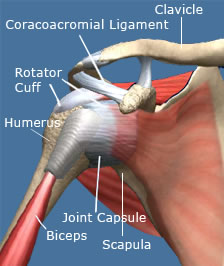 |
| |
Shoulder Arthroscopy
This is an effective tool for diagnosing and treating shoulder problems such as rotator cuff tears, labral tears, impingement, loose bodies and arthritis of the acromioclavicular joint. The surgeon examines your shoulder with an instrument called an arthroscope - a thin tube with a lens and light on the end that is inserted in your shoulder through a tiny portal incision. It then projects an image of the inside of your shoulder onto a TV monitor.
If the suspected problem is confirmed, the surgeon can place small instruments through additional portals, to repair tears in the rotator cuff or labrum, or to remove bone from the undersurface of the acromion or end of the clavicle to relieve impingement or arthritis. An arthroscopy can ultimately provide relief from shoulder pain and improve shoulder function. It can be performed as an outpatient under regional and/or general anesthesia. |
|
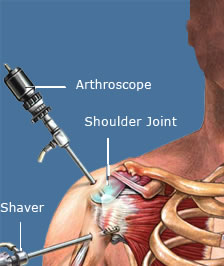 |
| |
Rotator Cuff Repair
A rotator cuff tear occurs when one or more of the rotator cuff tendons detaches from its insertion on the humerus. These tears do not heal on their own and can lead to significant shoulder pain and weakness.
Traditionally, these tears were repaired through an open surgical incision. Recently, however, arthroscopic repair has become an option for the majority of these tears. This allows for rotator cuff repair with less postoperative pain and scarring and potentially earlier return of shoulder movement. This newer, arthroscopic repair technique is only performed by certain orthopaedic surgeons, including those of Boca Raton Orthopaedics and Sports Medicine. |
|
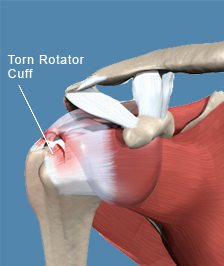 |
| |
Shoulder Replacement
In shoulder replacement surgery, damaged bone and cartilage are replaced with metal and plastic surfaces that are shaped to restore shoulder movement and function. The new artificial shoulder is called a prosthesis.
Stainless steel, cobalt/chrome alloys or titanium may be used for these components. Durable, wear resistant polyethylene (plastic) is used to resurface the glenoid. Bone cement may be used to anchor the prosthesis into the bone. Some joint replacements also can be implanted without cement when the prosthesis is designed to fit and lock onto the bone directly. The restoration of shoulder motion and relief from shoulder pain that this procedure offers can be life changing.
|
|
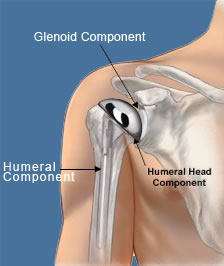 |
| |
Shoulder Separation
This is a fairly common injury, especially in certain contact sports including football, hockey and rugby. Shoulder separations are actually injuries to the acromioclavicular (AC) joint. With a shoulder separation, the ligaments that hold the acromion and clavicle together are torn. The clavicle migrates upward and backward relative to the acromion causing deformity of the shoulder. Depending on the severity of the injury and the number of ligaments torn, shoulder deformity and dysfunction may be mild, moderate or severe.
Most shoulder separations are treated conservatively with a brief period of sling immobilization followed by a course of physical therapy. Higher grade separations, however, require surgical intervention to correct the deformity and improve shoulder biomechanics.
|
|
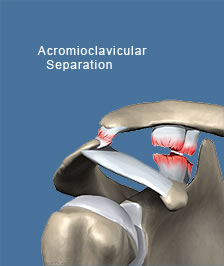 |
| 
